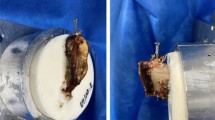Abstract
Purpose
Locked symphyseal plates are utilized to provide higher levels of construct stiffness than non-locked plates. The current biomechanical study was performed to compare stiffness at the pubic symphysis between locked and non-locked plating systems.
Methods
Synthetic models were utilized to represent injury to the pelvis and symphyseal plating combined with a sacro-iliac screw. Seven models were evaluated with plates and locking screws, and seven were evaluated with non-locking screws. Single limb stance was simulated, with all models loaded for 1000 cycles with 350 N applied at the sacrum. Two pairs of markers crossing the symphysis were tracked with a video-based tracking system. A coordinate system was developed to quantify motion between the pairs in three directions: medial–lateral gap, anterior–posterior shear translation, and superior–inferior shear translation. Significant differences between the plating systems were identified with t tests (p < 0.05).
Results
Anterior–posterior shear translation varied significantly between the two plating systems. From cycles 100 to 1000, average shear translation for the non-locked and locked systems was ~0.7 and 0.3 mm, respectively, at the markers closest to the plate and 2.2 and 1.4 mm, respectively, at the markers further from the plate. Motion in the other two directions did not differ significantly between locked and non-locked models.
Conclusions
Locked symphyseal plating systems can provide better stability than non-locked systems for anterior–posterior shear translation. More stability could potentially reduce the risk of failure of the plate or screws.


Similar content being viewed by others
References
Tile M, Hearn T, Vrahas M. Biomechanics of the pelvic ring. In: Tile M, Helfet DL, Kellam JF, editors. Fractures of the pelvis and acetabulum. 3rd ed. Philadelphia: Lippincott Williams & Wilkins; 2003. p. 32–45.
Moed BR, Grimshaw CS, Segina DN. Failure of locked design-specific plate fixation of the pubic symphysis: a report of six cases. J Orthop Trauma. 2012;26:e71–5.
Putnis SE, Pearce R, Wali UJ, Bircher MD, Rickman MS. Open reduction and internal fixation of a traumatic diastasis of the pubic symphysis: one-year radiological and functional outcomes. J Bone Joint Surg Br. 2011;93:78–84.
Sagi HC, Papp S. Comparative radiographic and clinical outcome of two-hole and multi-hole symphyseal plating. J Orthop Trauma. 2008;22:373–8.
Grimshaw CS, Bledsoe JG, Moed BR. Locked versus standard unlocked plating of the pubic symphysis: a cadaver biomechanical study. J Orthop Trauma. 2012;26:402–6.
Moed BR, O’Boynick CP, Bledsoe JG. Locked versus standard unlocked plating of the symphysis pubis in a Type-C pelvic injury: a cadaver biomechanical study. Injury. 2014;45:748–51.
Prasarn ML, Zych G, Gaski G, Baria D, Kaimrajh D, Milne T, Latta LL. Biomechanical study of 4-hole pubic symphyseal plating: locked versus unlocked constructs. Orthopedics. 2012;35:e1028–32.
Berber O, Amis AA, Day AC. Biomechanical testing of a concept of posterior pelvic reconstruction in rotationally and vertically unstable fractures. J Bone Joint Surg Br. 2011;93:237–44.
Yinger K, Scalise J, Olson SA, Bay BK, Finkemeier CG. Biomechanical comparison of posterior pelvic ring fixation. J Orthop Trauma. 2003;17:481–7.
Marsh JL, Slongo TF, Agel J, Broderick JS, Creevey W, DeCoster TA, Prokuski L, Sirkin MS, Ziran B, Henley B, Audigé L. Fracture and Dislocation Classification Compendium—2007: Orthopaedic Trauma Association Classification, Database and Outcomes Committee. J Orthop Trauma. 2007;21(10 Suppl):S1–133.
MacAvoy MC, McClellan RT, Goodman SB, Chien CR, Allen WA, van der Meulen MC. Stability of open-book pelvic fractures using a new biomechanical model of single-limb stance. J Orthop Trauma. 1997;11:590–3.
Schildhauer TA, Ledoux WR, Chapman JR, Henley MB, Tencer AF, Routt ML Jr. Triangular osteosynthesis and iliosacral screw fixation for unstable sacral fractures: a cadaveric and biomechanical evaluation under cyclic loads. J Orthop Trauma. 2003;17:22–31.
Burkhart SS, Denard PJ, Konicek J, Hanypsiak BT. Biomechanical validation of load-sharing rip-stop fixation for the repair of tissue-deficient rotator cuff tears. Am J Sports Med. 2014;42:457–62.
Besl PJ, McKay ND. A method for registration of 3-D shapes. IEEE Trans Pattern Anal Mach Intel. 1992;14:239–56.
Hamad A, Pavlou G, Dwyer J, Lim J. Management of pubic symphysis diastasis with locking plates: a report of 11 cases. Injury. 2013;44:947–51.
Acknowledgments
Funding and materials for the study were provided by DePuy Synthes.
Author information
Authors and Affiliations
Corresponding author
Ethics declarations
Conflict of interest
Gregory Vrabec received a research grant and materials from DePuy Synthes to conduct the study. Ryan Godinsky, Loredana Guseila, Danielle Filipkowski, and John Elias declare no conflict of interest.
Rights and permissions
About this article
Cite this article
Godinsky, R.J., Vrabec, G.A., Guseila, L.M. et al. Biomechanical comparison of locked versus non-locked symphyseal plating of unstable pelvic ring injuries. Eur J Trauma Emerg Surg 44, 179–184 (2018). https://doi.org/10.1007/s00068-016-0661-x
Received:
Accepted:
Published:
Issue Date:
DOI: https://doi.org/10.1007/s00068-016-0661-x




